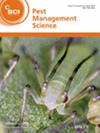Rational design and discovery of novel hydrazide derivatives as potent succinate dehydrogenase inhibitors inspired by natural d/l‐camphor
Peng Dai, Zihua Ma, Guangfu Yi, Yufei Li, Kaili Xie, Yafang Sun, Qing Xia, Zewen Liu, Weihua Zhang
求助PDF
{"title":"Rational design and discovery of novel hydrazide derivatives as potent succinate dehydrogenase inhibitors inspired by natural d/l‐camphor","authors":"Peng Dai, Zihua Ma, Guangfu Yi, Yufei Li, Kaili Xie, Yafang Sun, Qing Xia, Zewen Liu, Weihua Zhang","doi":"10.1002/ps.8481","DOIUrl":null,"url":null,"abstract":"BACKGROUNDSuccinate dehydrogenase inhibitors (SDHIs) have rapidly become one of the fastest‐growing categories of fungicides used against plant pathogenic fungi. Recent research advancements have emphasized that structural modifications of SDHIs using naturally sourced scaffolds represent an innovative strategy for developing new, highly effective, broad‐spectrum fungicides. A novel series of <jats:sc>d/l</jats:sc>‐camphorhydrazide derivatives potentially targeting fungal succinate dehydrogenase (SDH) were designed, synthesized and evaluated for their antifungal effects against <jats:italic>Rhizoctonia solani</jats:italic>, <jats:italic>Fusarium graminearum</jats:italic>, <jats:italic>Valsa mali</jats:italic> and <jats:italic>Botrytis cinerea</jats:italic>.RESULTSAmongst them, compounds A1‐7 (<jats:sc>d</jats:sc>‐camphor) and A2‐7 (<jats:sc>l</jats:sc>‐camphor) displayed excellent <jats:italic>in vitro</jats:italic> activity against <jats:italic>R. solani</jats:italic> with median effective concentration (EC<jats:sub>50</jats:sub>) values of 0.38 and 0.48 μg mL<jats:sup>−1</jats:sup>, which were obviously superior to that of boscalid (0.87 μg mL<jats:sup>−1</jats:sup>). A2‐5 (<jats:sc>l</jats:sc>‐camphor, EC<jats:sub>50</jats:sub> = 3.27 μg mL<jats:sup>−1</jats:sup>) exhibited good activity against <jats:italic>V. mali</jats:italic>. A2‐7 (2.13 μg mL<jats:sup>−</jats:sup>1), A2‐21 (5.2 μg mL<jats:sup>−1</jats:sup>) and A1‐5 (5.15 μg mL<jats:sup>−1</jats:sup>) showed good antifungal activity against <jats:italic>F. graminearum</jats:italic> with EC<jats:sub>50</jats:sub> values below that of boscalid (5.85 μg mL<jats:sup>−1</jats:sup>). Preliminary mechanistic studies, using scanning and transmission electron microscopy, indicated that compound A1‐7 induced disordered entanglement of hyphae, shrinkage of hyphal surfaces, and vacuole swelling and rupture, which disrupted normal hyphal growth. Additionally, compound A1‐7 induced the production and accumulation of reactive oxygen species, disrupted mitochondrial membrane potential, and effectively inhibited the germination and formation of sclerotia in <jats:italic>R. solani</jats:italic>. Moreover, the molecular docking results and SDH enzyme assays yielded promising outcomes.CONCLUSIONIn this study, the designed and optimized compounds A1‐7 and A2‐7 emerged as promising candidates for SDH‐targeting fungicides, demonstrating strong antifungal activity. These compounds hold potential as new antifungal agents for further research. © 2024 Society of Chemical Industry.","PeriodicalId":218,"journal":{"name":"Pest Management Science","volume":"1 1","pages":""},"PeriodicalIF":3.8000,"publicationDate":"2024-10-19","publicationTypes":"Journal Article","fieldsOfStudy":null,"isOpenAccess":false,"openAccessPdf":"","citationCount":"0","resultStr":null,"platform":"Semanticscholar","paperid":null,"PeriodicalName":"Pest Management Science","FirstCategoryId":"97","ListUrlMain":"https://doi.org/10.1002/ps.8481","RegionNum":1,"RegionCategory":"农林科学","ArticlePicture":[],"TitleCN":null,"AbstractTextCN":null,"PMCID":null,"EPubDate":"","PubModel":"","JCR":"Q1","JCRName":"AGRONOMY","Score":null,"Total":0}
引用次数: 0
引用
批量引用
Abstract
BACKGROUNDSuccinate dehydrogenase inhibitors (SDHIs) have rapidly become one of the fastest‐growing categories of fungicides used against plant pathogenic fungi. Recent research advancements have emphasized that structural modifications of SDHIs using naturally sourced scaffolds represent an innovative strategy for developing new, highly effective, broad‐spectrum fungicides. A novel series of d/l ‐camphorhydrazide derivatives potentially targeting fungal succinate dehydrogenase (SDH) were designed, synthesized and evaluated for their antifungal effects against Rhizoctonia solani , Fusarium graminearum , Valsa mali and Botrytis cinerea .RESULTSAmongst them, compounds A1‐7 (d ‐camphor) and A2‐7 (l ‐camphor) displayed excellent in vitro activity against R. solani with median effective concentration (EC50 ) values of 0.38 and 0.48 μg mL−1 , which were obviously superior to that of boscalid (0.87 μg mL−1 ). A2‐5 (l ‐camphor, EC50 = 3.27 μg mL−1 ) exhibited good activity against V. mali . A2‐7 (2.13 μg mL− 1), A2‐21 (5.2 μg mL−1 ) and A1‐5 (5.15 μg mL−1 ) showed good antifungal activity against F. graminearum with EC50 values below that of boscalid (5.85 μg mL−1 ). Preliminary mechanistic studies, using scanning and transmission electron microscopy, indicated that compound A1‐7 induced disordered entanglement of hyphae, shrinkage of hyphal surfaces, and vacuole swelling and rupture, which disrupted normal hyphal growth. Additionally, compound A1‐7 induced the production and accumulation of reactive oxygen species, disrupted mitochondrial membrane potential, and effectively inhibited the germination and formation of sclerotia in R. solani . Moreover, the molecular docking results and SDH enzyme assays yielded promising outcomes.CONCLUSIONIn this study, the designed and optimized compounds A1‐7 and A2‐7 emerged as promising candidates for SDH‐targeting fungicides, demonstrating strong antifungal activity. These compounds hold potential as new antifungal agents for further research. © 2024 Society of Chemical Industry.
受天然樟脑启发,合理设计和发现新型酰肼衍生物作为强效琥珀酸脱氢酶抑制剂
背景琥珀酸脱氢酶抑制剂(SDHIs)已迅速成为用于防治植物病原真菌的增长最快的杀菌剂类别之一。最近的研究进展强调,利用天然来源的支架对 SDHIs 进行结构改造是开发新型、高效、广谱杀菌剂的创新战略。研究人员设计、合成了一系列新型 d/l-樟脑酰肼衍生物,这些衍生物可能以真菌琥珀酸脱氢酶(SDH)为靶标,并评估了它们对根瘤菌、禾谷镰刀菌、苹果蠹蛾和灰霉病菌的抗真菌效果。结果其中,化合物 A1-7(d-樟脑)和 A2-7(l-樟脑)对根瘤菌(R. solani)显示出极佳的体外活性,有效浓度(EC50)中值分别为 0.38 和 0.48 μg mL-1,明显优于啶虫脒(0.87 μg mL-1)。A2-5 (l-樟脑,EC50 = 3.27 μg mL-1)对马立克病毒具有良好的活性。A2-7 (2.13 μg mL-1)、A2-21(5.2 μg mL-1)和 A1-5(5.15 μg mL-1)对禾谷镰孢表现出良好的抗真菌活性,其 EC50 值低于啶酰菌胺(5.85 μg mL-1)。使用扫描和透射电子显微镜进行的初步机理研究表明,化合物 A1-7 引发了菌丝的无序缠结、菌丝表面的收缩以及液泡的膨胀和破裂,从而破坏了正常的菌丝生长。此外,化合物 A1-7 还会诱导活性氧的产生和积累,破坏线粒体膜电位,并有效抑制 R. solani 的发芽和硬菌的形成。此外,分子对接结果和 SDH 酶测定结果均显示出良好的前景。这些化合物有望成为新的抗真菌剂,有待进一步研究。© 2024 化学工业协会。
本文章由计算机程序翻译,如有差异,请以英文原文为准。


